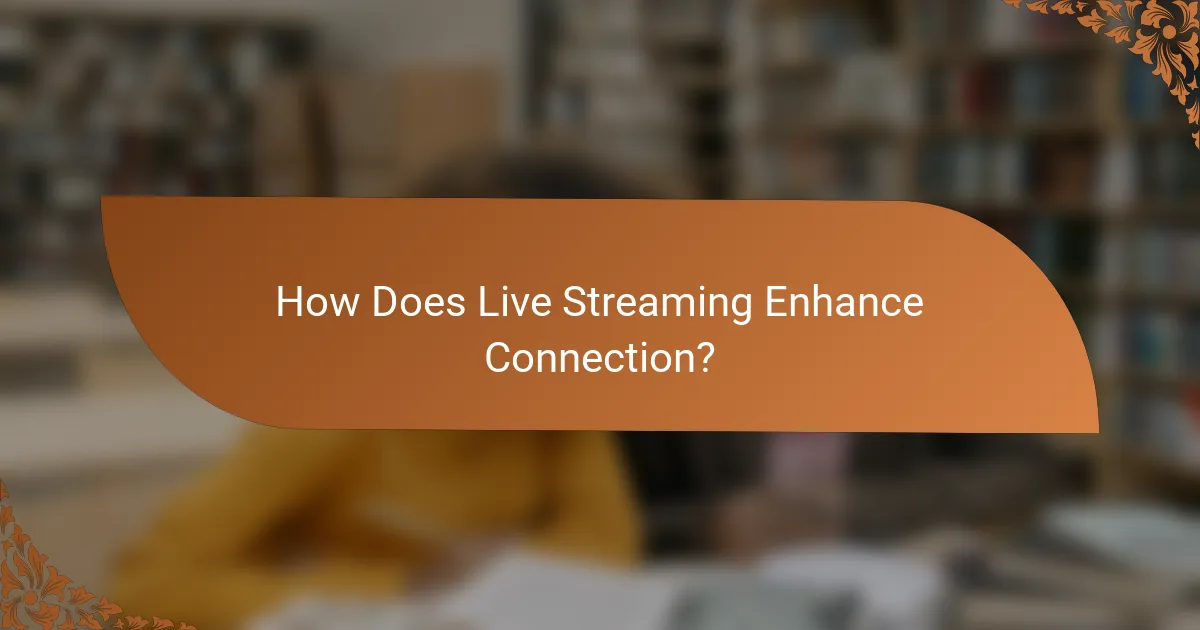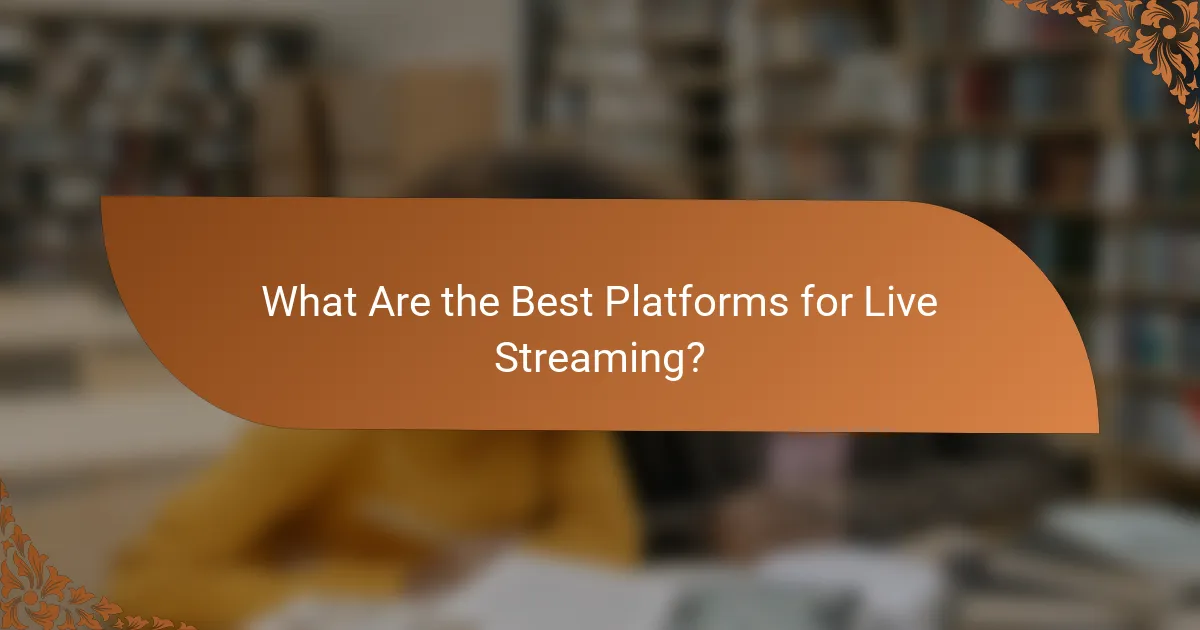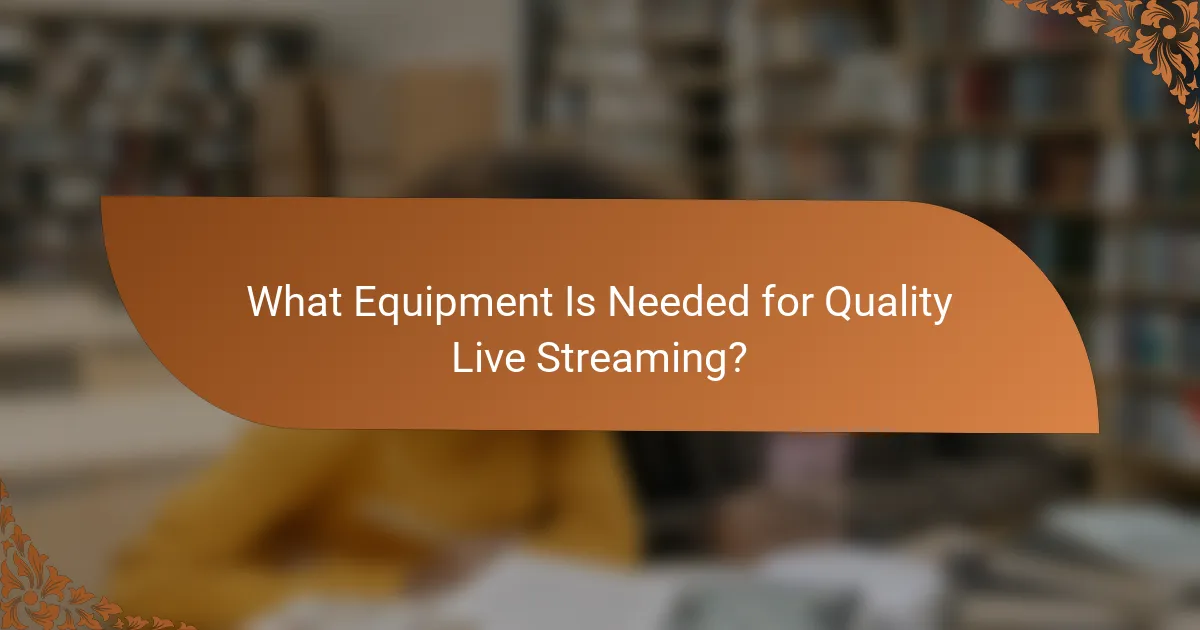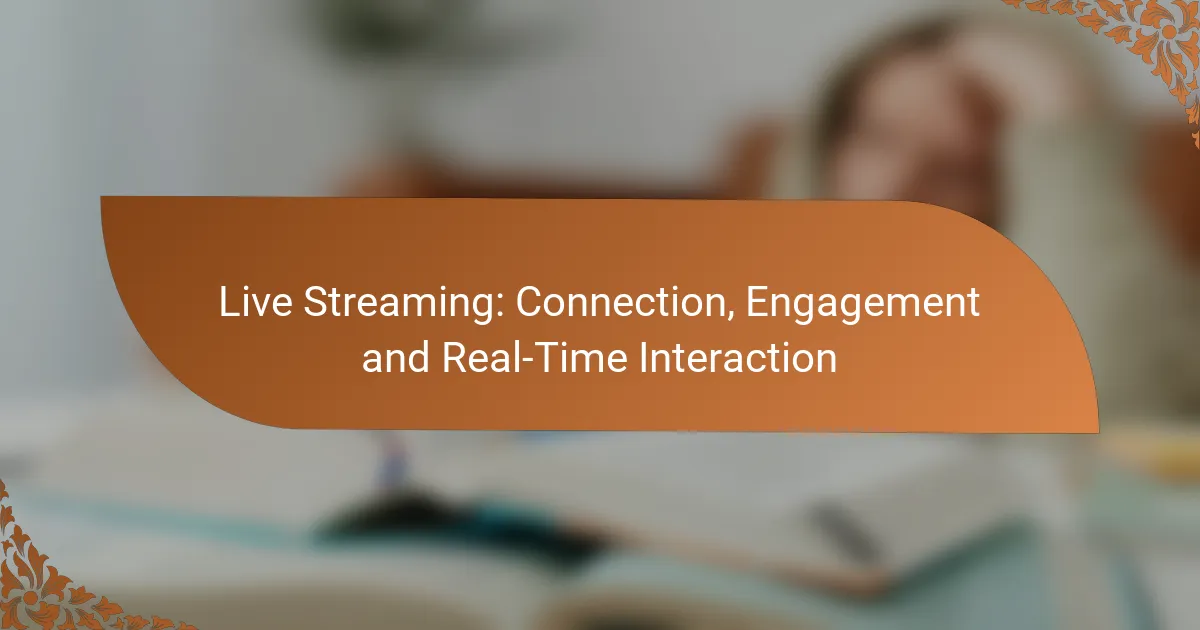Live streaming has revolutionized the way content creators connect with their audiences by facilitating real-time interaction and engagement. This immediacy fosters a sense of community that traditional media struggles to achieve, making it essential for creators to leverage platforms like Facebook Live, YouTube Live, and Twitch. By incorporating interactive elements such as polls and Q&A sessions, live streams can significantly enhance viewer participation and create a more dynamic experience.

How Does Live Streaming Enhance Connection?
Live streaming enhances connection by allowing real-time interaction between content creators and their audiences. This immediate engagement fosters a sense of community and personal connection that traditional media cannot replicate.
Real-time audience interaction
Real-time audience interaction is a key feature of live streaming that enables viewers to engage directly with the host. This can include asking questions, participating in polls, or reacting to content as it unfolds. Such interactions can occur within seconds, creating a dynamic atmosphere that keeps viewers invested.
Platforms like Twitch and YouTube Live offer chat functions that allow for instant feedback, making the experience more immersive. Creators can respond to comments live, which enhances viewer satisfaction and encourages ongoing participation.
Personalized viewer experiences
Live streaming allows for personalized viewer experiences through tailored content and direct engagement. Hosts can adjust their presentations based on audience reactions, making the content more relevant and appealing. For instance, if a host notices a spike in interest around a specific topic, they can delve deeper into that subject during the stream.
Additionally, many platforms enable creators to segment their audiences and address them individually, enhancing the feeling of connection. This personalization can lead to increased loyalty and a stronger following over time.
Community building through chats
Chats during live streams play a crucial role in community building by fostering interaction among viewers. Participants can share their thoughts, experiences, and support for one another, creating a sense of belonging. This communal aspect is often what keeps viewers returning for future streams.
Moreover, moderators can help maintain a positive environment by managing discussions and ensuring that interactions remain respectful. Encouraging viewers to engage with each other can turn a simple broadcast into a vibrant community hub, enhancing the overall experience for everyone involved.

What Are the Best Platforms for Live Streaming?
The best platforms for live streaming include Facebook Live, YouTube Live, Twitch, and Instagram Live. Each platform offers unique features and caters to different audiences, making it essential to choose one that aligns with your content and engagement goals.
Facebook Live
Facebook Live allows users to broadcast real-time video to their followers, making it ideal for personal updates, events, or brand promotions. It integrates seamlessly with Facebook’s social features, enabling viewers to comment and react during the stream.
To maximize engagement, promote your live session in advance and encourage viewers to interact through comments. Keep your broadcasts concise, ideally between 10 to 30 minutes, to maintain viewer interest.
YouTube Live
YouTube Live is a powerful tool for creators looking to reach a broad audience. It supports high-definition streaming and offers features like chat moderation and analytics to track viewer engagement. This platform is particularly effective for tutorials, gaming, and events.
Consider scheduling your streams and using eye-catching thumbnails to attract viewers. Aim for a duration of 30 minutes to an hour, which is often optimal for retaining audience attention and encouraging interaction.
Twitch
Twitch is primarily focused on gaming and entertainment, making it the go-to platform for gamers and content creators in that niche. It features live chat, allowing for real-time interaction with viewers, which is crucial for building a community.
Streamers should engage with their audience by responding to comments and incorporating viewer suggestions into their content. Regular streaming schedules can help build a loyal following, with sessions typically lasting from one to several hours.
Instagram Live
Instagram Live is perfect for casual, spontaneous broadcasts and is integrated into the Instagram app, making it easily accessible to users. It allows for real-time interaction through comments and the ability to invite other users to join the stream.
To enhance viewer engagement, promote your live sessions through stories and posts beforehand. Keep your streams short, ideally under 30 minutes, to cater to the platform’s fast-paced audience.

How to Increase Engagement During Live Streams?
To boost engagement during live streams, focus on interactive elements that invite viewer participation. Techniques such as polls, Q&A sessions, and giveaways can significantly enhance viewer involvement and create a more dynamic experience.
Utilizing polls and Q&A sessions
Polls and Q&A sessions are effective tools for engaging your audience in real-time. By asking viewers to vote on topics or submit questions, you create a sense of involvement and investment in the content being presented.
Consider using platforms that allow for instant polling, enabling viewers to respond quickly. This can lead to higher interaction rates and make the stream feel more like a conversation than a monologue.
Incorporating giveaways and contests
Giveaways and contests can attract more viewers and keep them engaged throughout the stream. Offering prizes related to your content can incentivize participation and encourage viewers to stay until the end.
For example, you might run a contest where viewers must answer questions based on the stream’s content to win a prize. Ensure that the rules are clear and that the prizes are appealing to your target audience.
Encouraging viewer participation
Encouraging viewers to participate actively can transform a passive viewing experience into an engaging one. Ask viewers to share their thoughts in the chat or respond to prompts during the stream.
Utilize call-to-action phrases like “Let me know your thoughts in the comments!” or “Share your experiences!” to motivate viewers to interact. Recognizing and responding to viewer comments can further enhance their sense of connection and community.

What Equipment Is Needed for Quality Live Streaming?
Quality live streaming requires a few essential pieces of equipment to ensure clear visuals and sound. The key components include high-definition cameras, professional microphones, and reliable streaming software.
High-definition cameras
High-definition cameras are crucial for delivering sharp and clear video during live streams. Look for cameras that support at least 1080p resolution, as this is the standard for quality streaming. Options range from DSLRs to dedicated camcorders, and even high-end webcams can suffice for smaller setups.
When selecting a camera, consider features like low-light performance and frame rates, which can enhance the viewing experience. For example, cameras with 60 frames per second (fps) provide smoother motion, which is particularly beneficial for fast-paced content.
Professional microphones
Professional microphones significantly improve audio quality, which is essential for engaging your audience. Options include lavalier mics for hands-free use, shotgun mics for focused sound capture, and USB microphones for easy computer connectivity. Each type serves different purposes depending on your streaming environment.
Investing in a good microphone can reduce background noise and enhance clarity. Consider using a pop filter to minimize plosive sounds, and always test your audio levels before going live to ensure a balanced sound.
Streaming software options
Streaming software is the backbone of any live streaming setup, allowing you to manage video feeds, overlays, and audience interaction. Popular options include OBS Studio, Streamlabs, and XSplit, each offering unique features tailored to different user needs.
When choosing streaming software, consider factors like ease of use, compatibility with your hardware, and available support. Many platforms offer free versions with basic functionality, which can be a great starting point for beginners before investing in premium features.

What Are the Key Metrics for Measuring Success?
Key metrics for measuring success in live streaming include viewer retention rates and engagement metrics. These indicators help assess how well your content resonates with the audience and how effectively it maintains their attention.
Viewer retention rates
Viewer retention rates indicate the percentage of viewers who stay for the entire duration of a live stream. High retention rates suggest that the content is engaging and relevant, while low rates may signal that viewers are losing interest.
To improve viewer retention, consider using compelling hooks at the beginning of your stream and maintaining a steady pace throughout. Aim for retention rates above 50% for optimal performance, but remember that this can vary based on content type and audience demographics.
Engagement metrics
Engagement metrics encompass various interactions viewers have with your stream, such as comments, likes, shares, and participation in polls. These metrics provide insight into how actively your audience is involved with the content.
To enhance engagement, encourage viewers to interact by asking questions or prompting discussions during the stream. Monitor engagement rates closely, aiming for a balance between viewer numbers and active participation, as this can significantly impact the overall success of your live streaming efforts.



